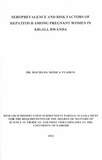| dc.description.abstract | Background
Hepatitis B virus belongs to the family Hepadnaviridae. It is the commonest cause of chronic
viral hepatitis. It is responsible for up to 80% of primary liver cancers. Despite the existence of a
safe and effective vaccine, HBV infections still remain a global public health problem. The
incorporation of the HBV vaccine into routine childhood immunization schedules has greatly
reduced morbidity and mortality due to HBV. However in areas of high endemicity new
infections still remain a concern. Pregnant women who are carriers of the virus pose a significant
risk to their unborn babies. Maternal HBV infection has also been associated with adverse
pregnancy outcomes including prematurity, gestational diabetes, perinatal deaths and
miscarriages as well as risk of mother to child transmission. Certain epidemiological risk factors
have been associated with HBV infection among pregnant women. These include women in
polygamous relationships, increasing parity, female genital mutilation, tribal marks and
scarification, living with a HBV infected partner, previous surgeries or dental procedures,
previous blood transfusions, body piercing and tattoos, working in a hospital and history of STls
Despite its public health importance, majority of countries in developing world, including
Rwanda have not yet adopted universal screening for pregnant women. Early diagnosis in this
group can provide an avenue for prevention of mother to child transmission which will in turn
lead to a reduction in the number of chronic carriers who act as a source of new infections.
Understanding the risk factors associated with HBV infection is paramount in adopting control
measures.
Objective
To determine the prevalence and risk factors of HBV infection among pregnant women in Kigali
Study design
A multi-centre, cross sectional study
Study sites
Muhima, Kibagabaga and Masaka Hospitals ANC clinics
x
Study Population
Pregnant women attending ANC clinics at the three hospitals who consented to join the study
Methodology
The study set out to determine the prevalence and risk factors for hepatitis B infection among
pregnant women in Kigali. It was a multicenter,cross-sectional study. Data collection was using a
questionnaire-guided interview followed by HBsAg determination using SD Bioline test
device.Data entry and statistical analysis was done using SPSS version 16. A p-value of less than
0.05 was considered significant. The information obtained shall be shared to health facilities involved and the Ministry of Health,
Rwanda. Apart from giving a snapshot of Hepatitis B disease burden among pregnant women in
Kigali, it also gives an indication of the disease burden in the general population. Risk factor
assessment useful in understanding the transmission dynamics of Hepatitis B in this set up and to
inform policy on transmission prevention.
Results
Three hundred and eighty five (385) pregnant women were recruited from from the three study
sites between May and August 2013. The mean age of the participants was 28 years. The ages
ranged between 15 years and 46 years with majority being between 25 and 29 years. Most of the
women had attained primary level education and most were earning less than one dollar a day.
The prevalence of Hepatitis B among pregnant women in Kigali is 3.1% (95% CI 1.7% to 5.3%).
The risk factors assessed for association with HBsAg positivity include history of contact with a
HBV positive person, history of blood transfusion and previous surgeries, tribal marks, body
piercings and tattoos, STIs and multiple sexual partners. The most frequently reported risk factor
was body piercing by 43.7% while history of working in a hospital was the least frequently
reported risk factor by 2.1% of the study participants. Statistical assessment of the risk factors in correlation with HBsAg positivity yielded low statistical power of association (p values above
0.05) using the chi square test of association or Fisher's test where frequencies were low.
Conclusion
According to WHO classification, Kigali has intermediate endemicity of Hepatitis B among
pregnant women. However, risk factors that have been linked with HBV infection among
pregnant women were not found to have statistically powerful correlation with HBsAg positivity.
Intermediate endemicity ofHBV infection among this group poses a risk of vertical transmission
to their unborn children as well as horizontal transmission to their contacts including delivery
staff.
Recommendations
Universal and free ante-natal screening to be adopted, and possibility of using a point of care
testing could be considered. Vaccination coverage to be expanded to include health care delivery
staff and family contacts of infected individuals.
Possibility of a birth dose of monovalent Hepatitis B vaccine to be considered in addition to the
existing three dose pentavalent vaccine | en_US |

